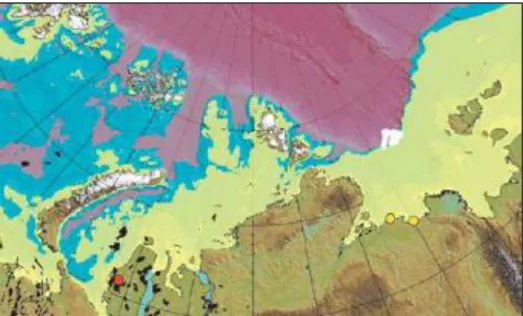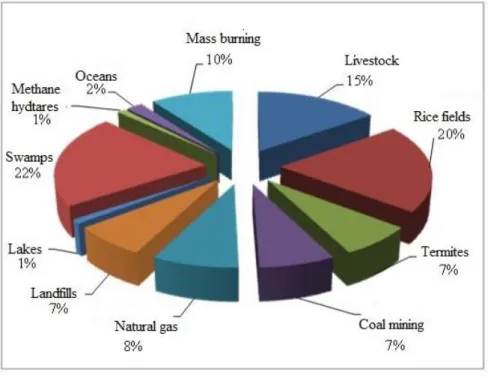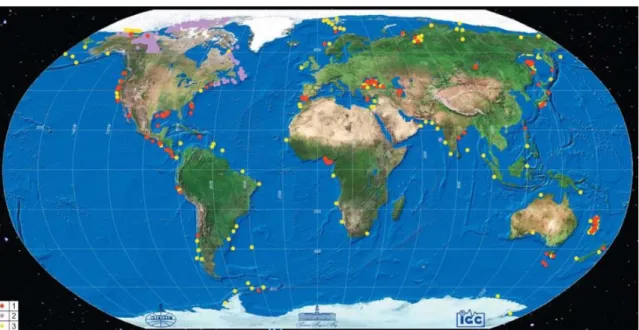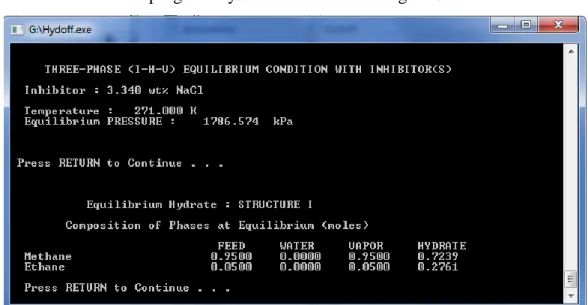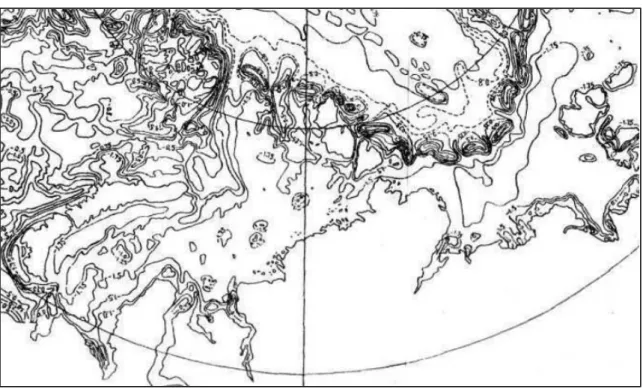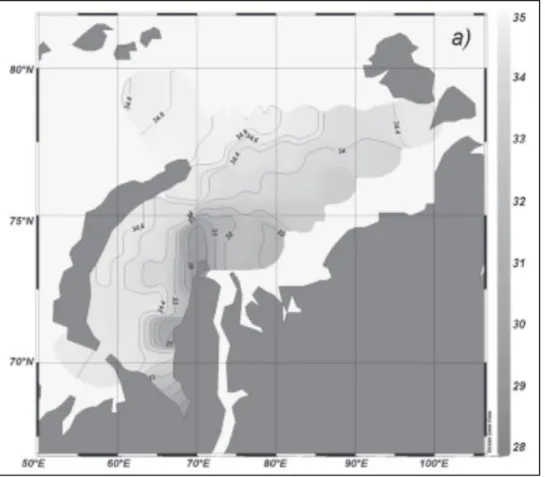Most gas hydrate reservoirs are located on the continental slopes of the oceans and in the Arctic region. The bottom relief of the Kara Sea is very uneven compared to the Laptev Sea. The aim of the master's work is to evaluate potential methane flows from the gas hydrate distribution areas in the sea shelves of the Kara and Lapt Seas.
Physicochemical properties of methane
More than 1/3 of methane emissions come from natural sources and slightly less than 2/3 from anthropogenic sources (Kiselev, Reshetnikov 2013). Anthropogenic sources are rice paddies, mines, livestock and losses from gas and oil extraction, biomass combustion, landfills (science-based proposals…2015). The heterogeneity of methane sources is the main reason for the large errors in the estimates of their intensity (Kiselev, Reshetnikov 2013).
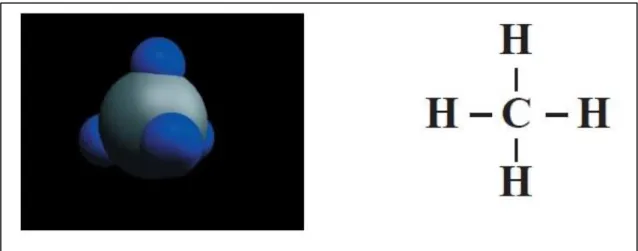
Impact on climate system
The hydrates are similar to ice, but can burn if ignited with a match (Collett et al. 2000). Since then, hydrates have been studied in the direction of leakage and prevention of their accumulation in pipelines and facilities of the oil industry (Collett et al. 2000). Then, in the 1970s, naturally occurring hydrates were discovered not only in polar continental regions, but also in sediments in oceanic marginal areas (Collett et al. 2000).
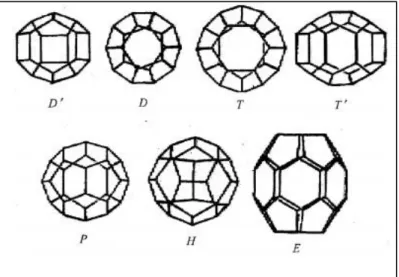
Gas hydrates distribution
In the 1960s, natural hydrates were discovered by a Russian drilling team in a Siberian gas field. Gas hydrate deposits have been discovered in Japan, on the east coast of the USA at Blake Ridge, near the continental border of Vancouver, British Columbia, Canada and offshore New Zealand. So, most of the open reservoirs with hydrates are located on the continental slopes of the oceans and in the Arctic, as can be seen on the map in Figure 5.
Gas hydrates in the Arctic Region
Traditionally oriented drilling technology on deep sediments does not include studies of the presence of gas hydrates. Scheme of the distribution of gas hydrates in the circumpolar region (IBCAO cartographic base). In addition to the area of favorable thermobaric conditions for the modern formation and preservation of gas hydrates, there is an area on the Arctic shelf.
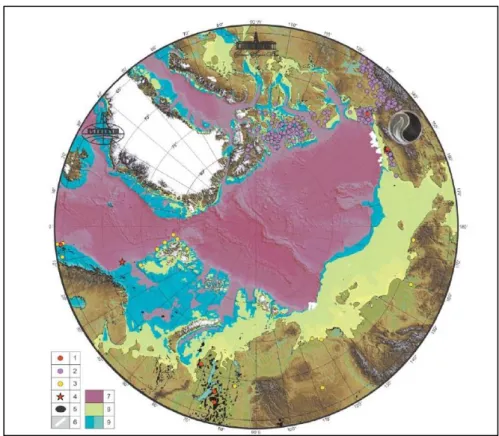
Gas hydrate stability zone
- Сoncept of stability of gas hydrates
- Hydoff (Hydrate prediction program)
- Bottom temperature
- Bottom salinity Kara Sea
- Geothermal gradient
It is determined by the intersection of the pressure-temperature phase boundary and the local geothermal gradient. As shown in figure 7 (b) for the marine environment, the top of the GHSZ occurs above the seabed. In the mouth areas of the sea, the temperature of the bottom water is determined by the size of the thermal runoff from the rivers.
Baydaratskaya Bay and the adjacent areas of the Yamal Peninsula stand out in the distribution of the bottom salinity of the Kara Sea. Negative temperatures indicate the winter origin of the bottom water masses in the area, and convective mixing (mainly due to ice formation) serves as a mechanism for the spread of low salinity values in the bottom horizons (Ermakova, Novikhin 2011). The bottom salinity of the Kara Sea according to Ermakova and Novikhin (2011) is shown in Figure 10.
Geothermal gradient is a physical characteristic that describes the increase in the temperature of rocks in °C on a certain part of the earth. The shelf of the Kara Sea is part of the eastern part of the West Arctic metaplatform. In the structure of the sedimentary cover can be traced its connection with the West Siberian plate.
As the crust ages, eastward, in the direction of the Siberian platform, the heat flux decreases (Khutorskoy et al. 2013).
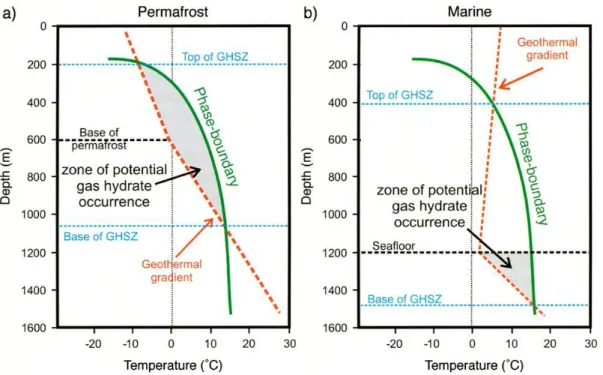
Methane fluxes
Organic carbon content
The Laptev Sea Plateau, located at the continental margin, on which the distribution axis of the Eurasian basin of the Arctic Ocean approaches orthogonally, has a typical structure for the margin margins. Active mid-ocean ridges approach the edges of continents, in addition to the Laptev Sea, only in the Gulf of California region in the Pacific Ocean and in the Gulf of Aden in the Indian Ocean (Khutorskoy et al. 2013). A very different nature of heat flow is observed on the Gakkel Ridge, the expanding ridge of the Arctic Ocean.
Relatively limited data on the thermal regime of sediments in the Arctic Ocean make it difficult to define the precise significance of geothermal gradient for the research areas of this master thesis. The main primary source of organic matter in the ocean is phytoplankton, which creates g Corg annually. Organic matter can also be produced by ice algae, phytobenthos (0.6* g Corg per year), which is made by macrophytes, diatoms living in silt, also chemolithotrophs in the ocean's fissure zones and in cold seeping fluids, which are widespread in the seas and at the edge of all oceans (Romankevich et al. 2009).
A huge amount of organic matter is brought from land by river runoff in dissolved (210 * g Corg per year) and suspended form (370 * g Corg per year), and its distribution in the ocean is very uneven. The mixing zone, where rivers empty into the ocean, plays a very important role in the deposition of various forms of organic matter, the sorption of trace elements and their distribution in the ocean. Over time, however, part of the sediments with organic matter may be transported to the lower continental slope and its foothills under the influence of gravity, tectonic movements or sea currents.
This determines the high fossilization coefficient of organic matter at the continental margin of the oceans (Romankevich et al 2009).
Methane content
Methane is formed in the third anaerobic methanogenic zone due to the breakdown of organic matter by bacteria (Whiticar 1999). According to the reaction, one mole and one mole of two moles of organic matter (O) are obtained. In this research, it was decided to determine where gas hydrates may lie directly near the bottom surface in the Kara Sea and the Laptev Sea.
Calculations were performed for submeredional and sublatitudinal profiles in the Kara and Laptev Seas (Figure 15). The points on the profiles are taken from different depths of the Kara and Laptev sea shelves. The map was made based on isobaths from GEBCO and then edited in Global Mapper and graphic editor.
Gas hydrates stability zone
For gas hydrate with 99% methane and 1% ethane (Table 2), the top of the GHSZ is at all points located above the seabed, so gas hydrates at all points can reach the bottom surface. For gas hydrates with 90% methane and 10% ethane (Table 4), gas hydrates in all points are also located near the bottom surface. For point 2 with the seabed depth (corresponding to the top of the GHSZ) at 433 m, gas hydrates with all types of gas mixture reach the seabed.
For point 3 with the depth of seabed at 530 m, gas hydrates with all types of gas mixtures reach the seabed. For point 4 with seabed depth at 530 m, gas hydrates with all types of gas mixtures reach the seabed. For gas hydrate with 95% methane and 5% ethane (table 7) the top of GHSZ is above the seabed in all points, and gas hydrates in all points reach the lower surface.
For point 6 with a seabed depth of 550 m, gas hydrates with all types of gas mixtures reach the seabed. For point 8 with a seabed depth of 380 m, gas hydrates with all types of gas mixtures reach the seabed. Gas hydrates with 95% methane and 5% ethane (Table 11) reach the bottom surface at all points except point 9.
For gas hydrates with 100% methane (Table 13), gas hydrates do not reach the bottom surface only at point 15 with the seabed depth of 190 m. For gas hydrates with 95% methane and 5% ethane, the base of the GHSZ is located below the seabed. At a depth of 190 m, only gas hydrates can be formed and reach the seabed for gas hydrate with 90% methane and 10% ethane.

GHSZ during late Pleistocene
If we compare the thickness of the GHSZ in the Kara and Laptev Seas, we can see that the GHSZ is thicker in the Kara Sea than in the Laptev Sea. Below on the graphs (figures), we can observe how the characteristics of the GHSZ changed in the present compared to the Late Pleistocene. For all other points, the GHSZ foundations of the present time lie deeper than those of the Late Pleistocene.
Characteristics of GHSZ in the present time/Late Pleistocene in submerged profile in the Kara Sea. For all other points the trend is the same, base of GHSZ for the present time is a little deeper than that for Late Pleistocene. Characteristics of GHSZ in the present time/Late Pleistocene in sublatitude profile in the Kara Sea.
Present-day/Late Pleistocene GHSZ characteristics in a submeredional profile in the Laptev Sea. The difference in GHSZ thickness between the two time periods ranges from 25 m for point 16 to 50 m for point 13. Present-day/Late Pleistocene GHSZ characteristics in a sublatitudinal profile in the Laptev Sea.
The base of the GHSZ of the selected points is currently located slightly deeper than it was in the late Pleistocene.
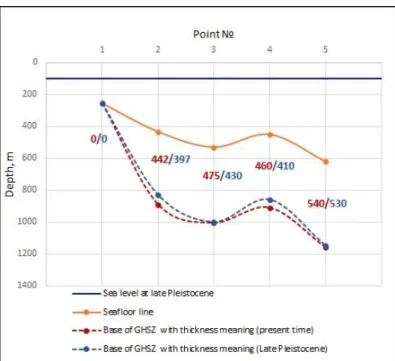
Methane fluxes
So thermobaric conditions are favorable for the formation of gas hydrates in most profile points. More complex research is needed to determine the presence of gas hydrates in the region and their vulnerability to climate change. Thermobaric conditions are favorable for the formation of gas hydrates in most profile points.
Destruction of gas hydrates in selected points is not approved by calculations of the amount of methane, which can be generated by bottom sediments. 2018) in their research on gas hydrates shows the cartographic diagram of the stability of methane hydrates in the Circumartian region. Destabilization of gas hydrate deposits and increased methane release can be caused by increasing the seabed temperature.
Malakhova et al. in their research estimated the sensitivity of the gas hydrates stability of the Arctic Ocean to the climate changes at the end of the 21st century. Thermobaric conditions for the formation of gas hydrates exist in most of the Arctic Ocean and in almost the entire Russian shelf of the Arctic. In this research, potential methane fluxes from gas hydrate distribution areas in the Kara and Laptev lake shelves were evaluated.
Nevertheless, thermobaric conditions are favorable for the formation of gas hydrates at most points of the profiles. More complex research is needed to determine the presence of gas hydrates in the region and their sensitivity to climate change. Kinetics of gas hydrate formation and dissociation in silica-stabilized aqueous dispersed media].
